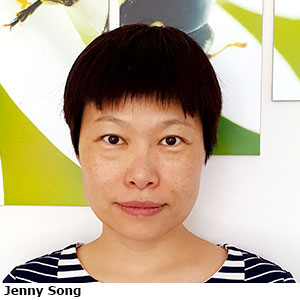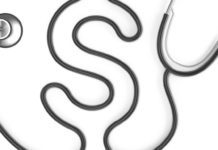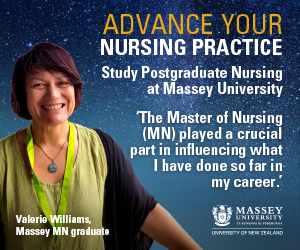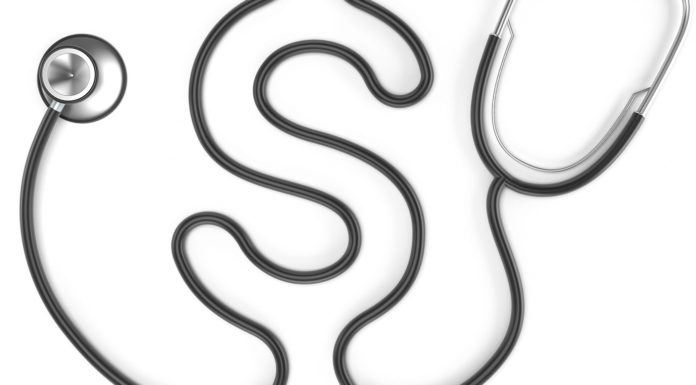 In our address to a group of nurses from the 600-bed Bao’an Central Hospital we mentioned that our local Waikato Hospital also had 600 inpatient beds, and a nursing staff of 2,260. There was a collective gasp from the audience.
In our address to a group of nurses from the 600-bed Bao’an Central Hospital we mentioned that our local Waikato Hospital also had 600 inpatient beds, and a nursing staff of 2,260. There was a collective gasp from the audience.
It was this nurse-to-patient ratio that elicited this response. Their hospital serves a population of 580,736 in the Bao’an district of the southern Chinese city of Shenzhen. The hospital has a staff of 1,564, but only 515 of these are nurses – and this figure includes nurses working in the community.
This made us realise how lucky we are in New Zealand, as in China a registered nurse’s patient load can be anywhere between 10–20 patients.
Bao’an was our first experience of teaching outside New Zealand and it followed meeting Zheng Ying Wang, the nursing director of Bao’an Central Hospital, earlier that year, when she undertook a 12-week Leadership and Management Workshop offered by Waikato Institute of Technology (Wintec) in Hamilton (see related article).
She invited us to conduct a workshop in Bao’an on a variety of different topics focusing on acute care. We arrived in Shenzhen, a city of 20 million people just north of Hong Kong, in June and spent a week working with our Chinese nursing colleagues and also meeting several times with the hospital’s management team.
We delivered sessions on the New Zealand health system, delirium, research, family-centred care and the development of critical thinking through simulation. We found we shared many of the same nursing interests and concerns and discovered many similarities and differences in nursing management and nursing culture.
The nursing workforce
The surprise at New Zealand’s nurse-to-patient ratios led to conversations with the nurses and the management team on how to manage staff shortages.
We were surprised to find ourselves in this advisory role but discussed our experiences of staff shortages and potential ways of managing them.
Hospital management told us that Bao’an is facing a critical nursing shortage. Ten percent of the nursing workforce is pregnant or planning to have a baby within the next year. This is in direct response to the Chinese government’s recent decision to end its one-child policy and allow families to have two children. The nursing shortage is compounded by the fact that in China most nurses retire around the age of 50. There was mutual amazement when we compared this with the New Zealand nursing workforce, in which 43 per cent of nurses are aged 50 years or older.
The nursing shortage, and accompanying workload issues, were areas of great concern to the management team of Boa’an Central Hospital. We had conversations with the hospital leaders around effective ways of using available nursing resources, such as having agency nurses or a casual resource pool. We thought this might draw interest from our Chinese colleagues.
However, it became obvious that there is no one-size-fits-all solution to the challenges of a nursing workforce shortage, and the concept of a pool of nurses was difficult for us to convey to the management team. The chance to further discuss such nursing concerns would have helped us critically examine the nursing context in China and gain more insights into challenges like China’s nursing shortage.
Alongside these meetings we were delivering education sessions to groups of around 100 nurses. Prior to arriving in China we had identified potential challenges, including presenting to such large groups of nurses, the language of delivery, and whether the New Zealand-developed content would make sense in China.
The sessions were to be conducted in English, as all nurses attending had indicated this was what they wanted.
However, soon into the first session it became apparent that many nurses did not have the level of English required. This resulted in the two of us delivering the sessions in English, but with Jenny (a native Chinese speaker who has lived in New Zealand for the past 13 years) immediately translating what we said into Chinese.
The challenges of teaching delirium assessment in the context of China
 Our first session was on nursing critically ill clients with acute confusion or delirium.
Our first session was on nursing critically ill clients with acute confusion or delirium.
Delirium is a word used to describe a state of acute confusion in a client, which is a common and severe clinical concern particularly in intensive care units (ICUs). Recent Chinese research by Zhang et al. has found that delirium contributes to a longer duration of ventilator use and high mortality rates in ICUs. However, other research indicates that nurses in China lack the knowledge and skills required to assess and manage clients with delirium.
The Confusion Assessment Method (CAM) is the most widely used assessment tool for an effective and accurate detection of delirium by health professionals.
During the delirium session, built around the CAM assessment tool, we discussed the nursing assessment skills needed to manage patients’ care, such as observing skills, communication skills and a holistic approach to assessing a patient’s mental status.
All the Chinese nurses attending were interested in delirium and actively shared clinical stories and personal experiences of working with clients/family members with acute confusional mental status.
The immediate challenge for us though was discovering the cultural differences that could affect the nurses’ understanding of such a westernised method of assessing delirium.
Modifications needed for culturally appropriate language
While it can be argued that using CAM to assess delirium is relevant in both western and Chinese contexts, we discovered that Chinese nurses could benefit from some modifications to the tool.
CAM was developed in a western context and has a series of questions and instructions written in English that are used to determine a client’s level of orientation. Some questions, such as inattention assessment questions that ask clients to count the letter ‘A’, must be modified to suit Chinese patients. So not only does the tool’s language need to be translated into Chinese, but the content also needs to be adapted.
We encouraged the Chinese nurses to review CAM and to consider how it could be adapted to meet their hospital’s needs. Adapting western tools to fit into the Chinese context has been done before, but it is not a simple process and requires intensive translation and a robust assessment of content validity.
Family-centred decision-making in traditional Chinese culture
We also identified that family-centred decision-making is an important concept in traditional Chinese culture.
Chinese people have strong family ties, with most patients accompanied by and cared for by their family members when in hospital. It is quite common for a patient to have more than one family member staying with them throughout their hospital stay. It is also expected that family members will provide basic patient care, such as washing, feeding and toileting. So when teaching the nursing management of delirium, we emphasised the importance of family education and family-centred decision-making.
Providing information on delirium to family members can increase their understanding of the patient’s health situation and directly reduce their distress. This approach helps to improve a family member’s competence and confidence in providing safe and effective care and can also empower them in family centred-decision making.
We were also asked to deliver a session on client-centred or patient-centred care. Given that family members were present for almost all health professional interactions with patients, we chose to focus on family-centred care.
This seemed to be a novel idea for many of the audience, with one nurse asking, “If my patient has a headache, I give them a pill. What am I supposed to do with the family?” The importance of providing ongoing explanations and education to family members as well as to patients led to good discussions and hopefully some changes in nursing practice.
Research and simulation
The other topics we discussed – nursing research and assessment through simulation – were also well received. Informing nurses on research methods and clinically focused research generated many potential topics for future research. This was an area in which the management team was particularly interested and is an area for future collaboration and development.
Simulation is also an area of potential growth in China as, while there appeared to be an understanding of how simulation can be used to develop practical clinical skills, there was little understanding of how it could be used to develop communication skills, teamwork and critical thinking. We only touched on these topics in our teaching but simulation is definitely worthy of further discussions.
The workshop sessions were very successful. Participant feedback showed they appreciated the opportunity to gain valuable clinical knowledge and skills in nursing critically ill patients with acute confusion. Some ICU nurses mentioned in group discussions that they now had increased confidence in their nursing assessment and management of delirium skills and in family-centred care. Some nurses even mentioned that they would like to step up to work on the CAM assessment tool and teach the valuable skills to their colleagues. Some nurses discussed research they could initiate within their areas of practice.
We believe that we have made a difference to nursing practice in Bao’an Central Hospital and therefore a positive difference to the nursing care delivered to patients and their families. We appreciate the amazing hospitality given by our Chinese colleagues and the leaders of Bao’an Central Hospital, and we also appreciate the privileged insight we were given into nursing in China.
AUTHORS: Jolanda Lemow and Jenny Song are academic staff members at Wintec, Hamilton.
References
- Nursing Council of New Zealand. (2015). The New Zealand nursing workforce. Retrieved from www.nursingcouncil.org.nz/Publications/Reports
- Panitchote A., Tangvoraphonkchai, K., Suebsoh, N., Eamma, W., Chanthonglarng, B., Tiamkao, S., & Limpawattana, P. (2015). Under-recognition of delirium in older adults by nurses in the intensive care unit setting. Aging Clinical and Experimental Research, 27(5), 735-40.
- Shi, Q., Warren, L., Saposnik, G. & MacDermid, J. C. (2013). Confusion assessment method: A systematic review and meta-analysis of diagnostic accuracy. Neuropsychiatric Disease and Treatment, 9, 1359-70.
- Waikato District Health Board. (2016). Snapshot of Waikato DHB. Retrieved from www.waikatodhb.health.nz/about-us/snapshot-of-waikato-dhb
- Wei, L. A., Fearing, M. A., Sternberg, E. J., & Inouye, S. K. (2008). The confusion assessment method (CAM): A systematic review of current usage. Journal of the American Geriatric Society, 56(5), 823-30.
- You, L., Aiken, L. H., Sloane, D. M., Liu, K.,He, G., & Hu, Y., … Sermeus, W. (2013). Hospital nursing, care quality, and patient satisfaction: Cross-sectional surveys of nurses and patients in hospitals in China and Europe. International Journal of Nursing Studies, 50(2), 154-61.
- Yue, P., Wang, L., Liu, C., & Wu, Y. (2015). A qualitative study on experience of nurses caring for patients with delirium in ICUs in China: Barriers, burdens and decision making dilemma. International Journal of Nursing Sciences, 2(1), 2-8.
- Zhang, W., Hu, W., Shen, M., Ye, X., Huang, Y., & Sun, Y. (2016). Profiles of delirium and the clinical outcomes of patients who underwent coronary artery bypass grafting: A prospective study from China. Journal of Clinical Nursing, 25(5-6), 631-41.
























